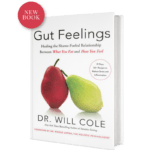How Air Pollution Is Bad For Your Health (And What To Do)

Air pollution is a term you’ve probably heard hundreds of times. We learn about it in our classrooms as children, we think about it every time we pass a factory, and we know that it’s typically worse in cities than in rural areas.
We also know that it’s bad for our health and the health of the planet.
But what is air pollution, really? Is there anything we can do to mitigate its effects on our health? Keep reading for everything I tell my patients about the dangers of air pollution on everything from your lung health to your heart to the health of your kids.
ARTICLE CONTINUES BELOW
Make Your Life a Cleanse
SUBSCRIBER-ONLY GUIDES FOR GUT HEALTH, VIBRANT ENERGY, HEALTHY FOOD & CLEAN ALCOHOL
Get FREE access to these + giveaways, recipes, & discount codes in personal emails from Dr. Will Cole.
What Is Air Pollution?
Air pollution is the presence of harmful substances in the air that can cause harm to anyone breathing them in. These substances can be the product of chemicals from factories, car emissions, or natural factors like exposure to mold spores, dust, and pollen.
We typically think about air pollution as something that happens outdoors, but it can also occur inside. Depending on what’s happening in your home, that indoor air may be just as polluted as the outdoor air, regardless of whether your home is in a rural or industrial area. (1)
The products we use inside are to blame. Concentrations of products containing harmful chemicals can persist in the air for much longer in areas with little ventilation than they would disperse outside.
How Air Pollution May Harm Your Health
Air pollutants aren’t something we’re meant to inhale. Research has shown that extended exposure to some pollutants can be even more damaging to your respiratory tract health than smoking a pack of cigarettes a day. (2) That means an increased risk of lung disease and lung cancer, acute and chronic respiratory conditions, allergies, emphysema, and asthma. (3)
While people with existing respiratory disorders are at a higher risk of being harmed by air pollution, it can put you at risk for other health conditions, too.
Cardiovascular disease, a higher risk of heart attacks, diabetes, and a variety of neurological and immune system disorders are all linked to worse outcomes thanks to air pollution. (4) Painful conditions like burning mouth syndrome (BMS) can also be caused by toxin exposure.
Air pollution can even impact the less tangible parts of our day. It can affect mental health, especially in children, productivity at work, and even stock market performance. (5) It can mess with your sleep and, most alarmingly, shorten your lifespan. (6, 7)
Air pollution is one of the biggest global health risks, so it’s important to understand your personal risk level when it comes to the health impacts of air pollution.
@drwillcole Stress less, live longer. Who’s with me??! Listen to this episode with Torrey DeVitto for all of her pro tips on mind-body healing + spirituality. Available anywhere you get your podcasts! #functionalmedicine #dearmedia #torreydevitto ♬ original sound - Dr. Will Cole
Are You At Risk?
People across all age groups and demographics can experience the negative effects of high pollution levels, but there are certain populations at a higher risk:
- Children
- Older adults
- Pregnant women (8)
- Anyone with pre-existing respiratory conditions like asthma, bronchitis, or chronic obstructive pulmonary disease (COPD)
- Anyone with a compromised immune system
Your environment matters, too. Those living in urban areas with high levels of car emissions, industrial zones, or areas prone to wildfires are in a higher risk category. People with lower incomes are more likely to live in areas with less access to clean air resources. (9)
No one is completely immune from pollution, even those in remote areas.
Particulate matter can be a problem indoors and outdoors, so it’s important to be aware of the dangers whether you live in the city or the country.
The Most Dangerous Pollutants
There are dozens of types of pollutants and sources of air pollution, each with its own health risks, but they can be roughly divided into a few key categories. (10)
1. TRAP
Traffic-related air pollution (TRAP) is the result of motor vehicle emissions. (11) This type of pollution contains ozone, carbon, nitrogen oxides, sulfur dioxide, volatile organic compounds, and fine particulate matter.
If you commute to work in a car or live in a densely populated urban area, there’s no way around this one.
2. Ozone
The ozone layer above is what protects us from the sun’s most harmful rays. If it’s closer to us as ground-level ozone, it becomes harmful. Ground-level ozone is the result of chemical reactions caused by pollutants from sources like car tailpipes, factories, refineries, and wastewater.
Ozone pollution is typically worse when it’s hot and sunny, so this one has definitely been exacerbated by climate change. If you’re vulnerable to air pollution and airborne contaminants, stay inside on high-ozone days.
3. Noxious gases
Noxious gases include carbon dioxide, carbon monoxide, nitrogen oxides (including nitrogen dioxide), and sulfur oxides, which are typically the result of industrial emissions and vehicles. They have a long shelf life, which makes them especially toxic. (12)
The toxicity of these gases doesn’t mean they’re harder to find indoors. Natural gas stoves can release carbon monoxide and formaldehyde into the air.
4. Particulate matter
Particulate matter includes sulfates, nitrates, carbon, and mineral dust produced by fossil fuels, cigarette smoke, and the burning of natural sources, like in the case of wildfires.
Interesting fact: When you see face masks with PM2.5 on the side, PM stands for particulate matter, and 2.5 stands for the size of the fine particles the mask is able to filter.
How To Protect Yourself
The bad news is that pollutants are everywhere, and you can’t avoid them entirely. The good news is that you can take steps to drastically reduce your exposure to air pollution, both indoors and outdoors, and support your body’s ability to fend off pollution-related illnesses.
1. Familiarize Yourself With The Air Quality In Your Area
The first step in protecting yourself from air pollution is knowing how to check the air quality index in your area. Luckily, this one is easy.
Just go to AirNow.gov, enter your zip code, and you’ll be able to see a report of the air quality data near you. Outdoor air pollution is a big enough risk factor for me that I would consider factoring it in if and when you move.
2. Avoid Exposure When Air Quality Is Poor
I recommend getting in the habit of checking for poor air quality regularly. This can help you make smarter decisions about exposure.
I’m all about connecting with nature, but only when it’s done safely. If the air quality outside is low one day due to wildfires, do an indoor workout instead of a jog outside or postpone that picnic plan for another weekend.
3. Avoid Areas With Idling Vehicles
As a general rule, avoid walking and exercising near highways, bus routes, or other high-traffic areas. Avoid standing or walking near idling cars or buses. If you’re sitting in traffic, keep the windows closed.
This is especially important for children. Playgrounds near roadways aren’t the best places for kids to play.
4. Use Green Cleaning Products
The average American home contains dozens of synthetic chemicals that contribute to indoor air pollution. This includes cleaners, aerosols, paints, air fresheners, and even candles. Even short-term exposure can cause shortness of breath and worsen asthma and allergy symptoms.
Ingredients to look for on product labels are ethylene-based glycol ethers and terpenes. (13) Both have been linked to increased rates of asthma, non-allergy stuffiness, and skin irritation.
Quick note here: Skin concerns like eczema and psoriasis can have a negative effect on your immune system, too, so it’s important to be aware of new symptoms you see and feel.
To choose healthier household products, follow these tips:
- Avoid products with words like “Poison” or “Danger” on them. The potential danger of that product can’t get much clearer.
- Look for the Safer Choice label. This signal from the United States Environmental Protection Agency (EPA) is available on nearly 2,000 different products.
- Know your triggers. Some products contain potential allergens that aren’t necessarily toxic but may cause respiratory symptoms. Fragrances are a common issue here.
You can always make your own green cleaners, too. A 50/50 ratio of water to white vinegar is good enough for most household tasks.
5. Buy An Air Filter
To filter indoor air, invest in a high-efficiency particulate air (HEPA) filter. HEPA filters are the gold standard for reducing indoor air issues. Studies show the filters are efficient at trapping even the smallest particles, especially as a mitigation measure in times of smog or smoke. (14)
If you're not sure which type of filter to buy, start with these tips:
- Measure your space. You want to know the square footage of the rooms that need filtering before starting your search. Target rooms with the most foot traffic.
- Choose a filter with a Clean Air Delivery Rate (CADR) that is about two-thirds of that square footage. You should see this on the filter’s label.
- While you’re reading labels, look for filters that are Energy Star certified. They’ll be more efficient.
Once you have your machine, clean and replace the filters inside regularly. Set a calendar note for what the manufacturer recommends. (It could be anywhere from 3-12 months.)
6. Ensure Your Kitchen Is Well-Ventilated
Cooking can release gases and particles in the air that can be bad for your health. To avoid this, make sure that your kitchen is well-ventilated.
Open the windows and doors when you’re cooking, place an air filter in that area, and avoid using oils at temperatures above their smoking point. Keep children out of the kitchen when you know there may be smoke involved.
7. Lead A Healthy Lifestyle
The healthier you are, the less likely you are to experience the worst symptoms from exposure to air pollution. Studies show diets rich in omega-3s from fatty fish can counter some of those negative health effects. (15)
Strengthen your lung health with physical exercise and deep breathing exercises. Be aware of any additional toxins in your life. If you smoke, now is the time to quit!
Considerations For Your Kids
Children are in the high-risk category for issues that can arise from long-term air pollution exposure. It can slow developmental outcomes, cause neurological deficits, and put them at risk for asthma and respiratory infections. (16)
This is because their bodies are still developing, making them more susceptible to inhaled particulates. (17) Children often spend more time playing outside, too. This increases their exposure to outdoor pollutants.
You can keep the kids you know and love safer from air pollution. To help mitigate the risks of air pollution for children, follow these tips:
- Limit outdoor play during high pollution times, e.g. wildfire season and smoggy days.
- Seek out playgrounds that aren’t near busy roads or idling cars when possible.
- Use cleaner cooking fuels at home, especially when children are present.
- Keep children away from smoke.
- Promote a healthy diet and lifestyle for children. The healthier a child is, the less likely they are to develop serious side effects from air pollution exposure.
Teaching children about the effects of air pollution can go a long way to protecting them in the long-term. Kids are innately curious and likely have questions about pollution-adjacent topics that you can explore together.
Awareness of the risks explained in an age-appropriate way can set them up to become better advocates for themselves, too. Your healthcare provider can be a great resource for you around additional tools to protect you and your kids from harmful pollutants.
Read Next: The Best Essential Oils for Allergies + How to Use Them
If you’re looking for a provider who takes a holistic approach to health, schedule a constultion with me. As one of the first functional medicine telehealth clinics in the world, we provide webcam health consultations for people around the globe.
FAQs
Climate change can make air quality worse by altering weather patterns and increasing the frequency of wildfires, storms, and big temperature swings. These events can release more particulates into the air, increase ground-level ozone, and worsen air quality.
Living in a polluted city can have long-term health effects like an increased risk of respiratory diseases and heart disease and diminished lung function. It has also been linked to an increased risk of premature death and negative effects in children, like low birth weight.
Ambient air quality standards for particulate matter are set by organizations like the World Health Organization (WHO) and the EPA. As of 2024, the EPA’s annual PM2.5 standard is set at 9.0 micrograms per cubic meter.
Start Your Health Journey Today
FUNCTIONAL MEDICINE CONSULTATIONS FOR PEOPLE AROUND THE WORLD
- Myers, I. & Maynard, R.L. (2005). Polluted air--outdoors and indoors. Occupational Medicine (London), 55(6), 432-438.
- Wang, M., Aaron, C.P., Madrigano, J., et al. (2019). Association between long-term exposure to ambient air pollution and change in quantitatively assessed emphysema and lung function. JAMA, 322(6), 546-556.
- Maio, S., Sarno, G., Tagliaferro, S., et al. (2023). Outdoor air pollution and respiratory health. The International Journal of Tuberculosis and Lung Disease, 27(1), 7-12.
- Abdul-Rahman, T., Roy, P., Bliss, Z.S.B., et al. (2024). The impact of air quality on cardiovascular health: A state of the art review. Current Problems in Cardiology, 49(2), 102174.
- He, Z., Zhao, Y., & Zheng, L. (2023). How does air pollution affect the stock market performance? Evidence from China. Environmental Science and Pollution Research, 30(27), 70636-70648.
- Zhang, Y., Ke, L., Ma, X., et al. (2023). Impact of ground-level ozone exposure on sleep quality and electroencephalogram patterns at different time scales. Environmental Research, 218, 115025.
- Lelieveld, J., Pozzer, A., Pöschl, U., et al. (2020). Loss of life expectancy from air pollution compared to other risk factors: a worldwide perspective. Cardiovascular Research, 116(11), 1910-1917.
- Johnson, N.M., Hoffmann, A.R., Behlen, J.C., et al. (2021). Air pollution and children's health-a review of adverse effects associated with prenatal exposure from fine to ultrafine particulate matter. Environmental Health and Preventative Medicine, 26(1), 72.
- Jbaily, A., Zhou, X., Liu, J., et al. (2022). Air pollution exposure disparities across US population and income groups. Nature, 601(7892), 228-233.
- Sicard, P., Agathokleous, E., Anenberg, S.C., et al. (2022). Trends in urban air pollution over the last two decades: A global perspective. Science of the Total Environment, 858(Pt 2), 160064.
- Matz, C.J., Egyed, M., Hocking, R. et al. (2019). Human health effects of traffic-related air pollution (TRAP): a scoping review protocol. Systematic Reviews, 8, 223.
- Bessac, B.F. & Jordt, S.E. (2010). Sensory detection and responses to toxic gases: mechanisms, health effects, and countermeasures. Proceedings of the American Thoracic Society, 7(4), 269-277.
- Choi, H., Schmidbauer, N., Spengler, J., et al. (2010). Sources of propylene glycol and glycol ethers in air at home. International Journal of Environmental Research and Public Health, 7(12), 4213-4237.
- Dubey, S., Rohra, H., & Taneja, A. (2012). Assessing effectiveness of air purifiers (HEPA) for controlling indoor particulate pollution. Heliyon, 7(9), e07976.
- Healy, D.R., Kårlund, A., Mikkonen, S., et al. (2024). Associations of low levels of air pollution with cardiometabolic outcomes and the role of diet quality in individuals with obesity. Environmental Research, 242, 117637.
- Olsson, D., Forsberg, B., Bråbäck, L., et al. (2021). Early childhood exposure to ambient air pollution is associated with increased risk of paediatric asthma: An administrative cohort study from Stockholm, Sweden. Environment International, 155, 106667.
- Schwartz, J. (2004). Air pollution and children's health. Pediatrics, 113(4 Suppl), 1037-1043.
The information on this website has not been evaluated by the Food & Drug Administration or any other medical body. We do not aim to diagnose, treat, cure or prevent any illness or disease. Information is shared for educational purposes only. You must consult your doctor before acting on any content on this website, especially if you are pregnant, nursing, taking medication, or have a medical condition.
Our content may include products that have been independently chosen and recommended by Dr. Will Cole and our editors. If you purchase something mentioned in this article, we may earn a small commission.

BY DR. WILL COLE
Dr. Will Cole, DNM, IFMCP, DC is a leading functional medicine expert who consults people around the globe, starting one of the first functional medicine telehealth centers in the world. Named one of the top 50 functional and integrative doctors in the nation, Dr. Will Cole provides a functional medicine approach for thyroid issues, autoimmune conditions, hormonal imbalances, digestive disorders, and brain problems. He is also the host of the popular The Art of Being Well podcast and the New York Times bestselling author of Intuitive Fasting, Ketotarian, Gut Feelings, and The Inflammation Spectrum.

Gut Feelings
Healing The Shame-Fueled Relationship
Between What You Eat And How You Feel
